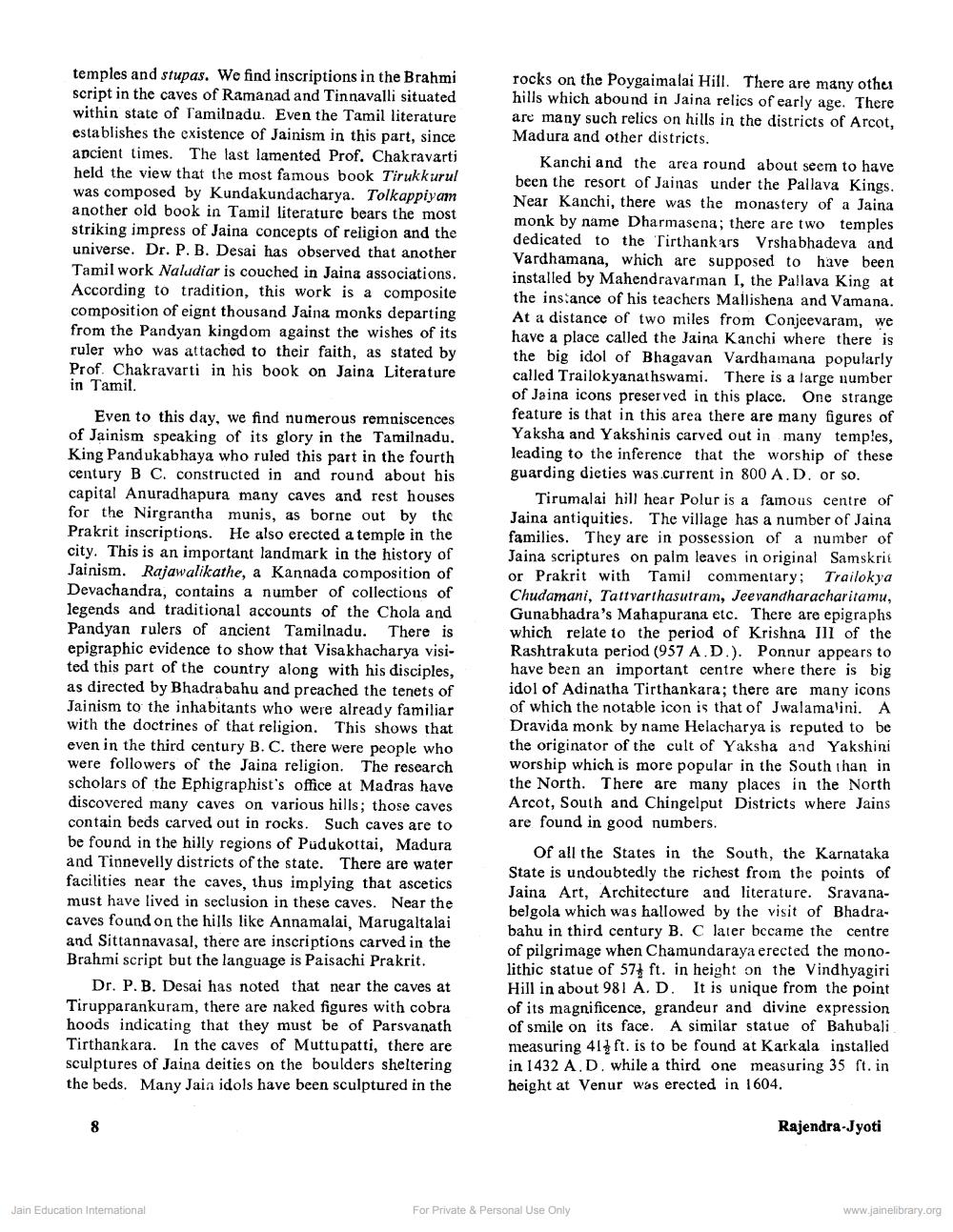Book Title: Jainism in South India Author(s): T K Tukol Publisher: Z_Rajendrasuri_Janma_Sardh_Shatabdi_Granth_012039.pdf View full book textPage 3
________________ temples and stupas. We find inscriptions in the Brahmi script in the caves of Ramanad and Tinnavalli situated within state of Tamilnadu. Even the Tamil literature establishes the existence of Jainism in this part, since apcient times. The last lamented Prof. Chakravarti held the view that the most famous book Tirukkurul was composed by Kundakundacharya. Tolkappiyam another old book in Tamil literature bears the most striking impress of Jaina concepts of religion and the universe. Dr. P. B. Desai has observed that another Tamil work Naludiar is couched in Jaina associations. According to tradition, this work is a composite composition of eignt thousand Jaina monks departing from the Pandyan kingdom against the wishes of its ruler who was attached to their faith, as stated by Prof. Chakravarti in his book on Jaina Literature in Tamil Even to this day, we find numerous remniscences of Jainism speaking of its glory in the Tamilnadu. King Pandukabhaya who ruled this part in the fourth century BC. constructed in and round about his capital Anuradhapura many caves and rest houses for the Nirgrantha munis, as borne out by the Prakrit inscriptions. He also erected a temple in the city. This is an important landmark in the history of Jainism. Rajawalikathe, a Kannada composition of Devachandra, contains a number of collections of legends and traditional accounts of the Chola and Pandyan rulers of ancient Tamilnadu. There is epigraphic evidence to show that Visakhacharya visited this part of the country along with his disciples, as directed by Bhadrabahu and preached the tenets of Jainism to the inhabitants who were already familiar with the doctrines of that religion. This shows that even in the third century B. C. there were people who were followers of the Jaina religion. The research scholars of the Ephigraphist's office at Madras have discovered many caves on various hills; those caves contain beds carved out in rocks. Such caves are to be found in the hilly regions of Pudukottai, Madura and Tinnevelly districts of the state. There are water facilities near the caves, thus implying that ascetics must have lived in seclusion in these caves. Near the caves found on the hills like Annamalai, Marugaltalai and Sittannavasal, there are inscriptions carved in the Brahmi script but the language is Paisachi Prakrit. Dr. P.B. Desai has noted that near the caves at Tirupparankuram, there are naked figures with cobra hoods indicating that they must be of Parsvanath Tirthankara. In the caves of Muttupatti, there are sculptures of Jaina deities on the boulders sheltering the beds. Many Jain idols have been sculptured in the rocks on the Poygaimalai Hill. There are many other hills which abound in Jaina relics of early age. There are many such relics on hills in the districts of Arcot, Madura and other districts. Kanchi and the area round about seem to have been the resort of Jainas under the Pallava Kings. Near Kanchi, there was the monastery of a Jaina monk by name Dharmasena; there are two temples dedicated to the Tirthank ars Vrshabhadeva and Vardhamana, which are supposed to have been installed by Mahendravarman I, the Pallava King at the instance of his teachers Mallishena and Vamana. At a distance of two miles from Conjcevaram, we have a place called the Jaina Kanchi where there is the big idol of Bhagavan Vardhamana popularly called Trailokyanathswami. There is a large number of Jaina icons preserved in this place. One strange feature is that in this area there are many figures of Yaksha and Yakshinis carved out in many temples, leading to the inference that the worship of these guarding dieties was.current in 800 A.D. or so. Tirumalai hill hear Polur is a famous centre of Jaina antiquities. The village has a number of Jaina families. They are in possession of a number of Jaina scriptures on palm leaves in original Samskrit or Prakrit with Tamil commentary: Trailokya Chudamani, Tattvarthasutram, Jeevandharacharitamu, Gunabhadra's Mahapurana etc. There are epigraphs which relate to the period of Krishna Ill of the Rashtrakuta period (957 A.D.). Ponnur appears to have been an important centre where there is big idol of Adinatha Tirthankara; there are many icons of which the notable icon is that of Jwalamalini. A Dravida monk by name Helacharya is reputed to be the originator of the cult of Yaksha and Yakshini worship which is more popular in the South han in the North. There are many places in the North Arcot, South and Chingelput Districts where Jains are found in good numbers. Of all the States in the South, the Karnataka State is undoubtedly the richest from the points of Jaina Art, Architecture and literature. Sravanabelgola which was hallowed by the visit of Bhadrabahu in third century B. C later became the centre of pilgrimage when Chamundaraya erected the monolithic statue of 571 ft. in height on the Vindhyagiri Hill in about 981 A. D. It is unique from the point of its magnificence, grandeur and divine expression of smile on its face. A similar statue of Bahubali measuring 41 ft. is to be found at Karkala installed in 1432 A.D, while a third one measuring 35 ft. in height at Venur was erected in 1604. Rajendra-Jyoti Jain Education International For Private & Personal Use Only www.jainelibrary.orgPage Navigation
1 2 3 4 5 6
